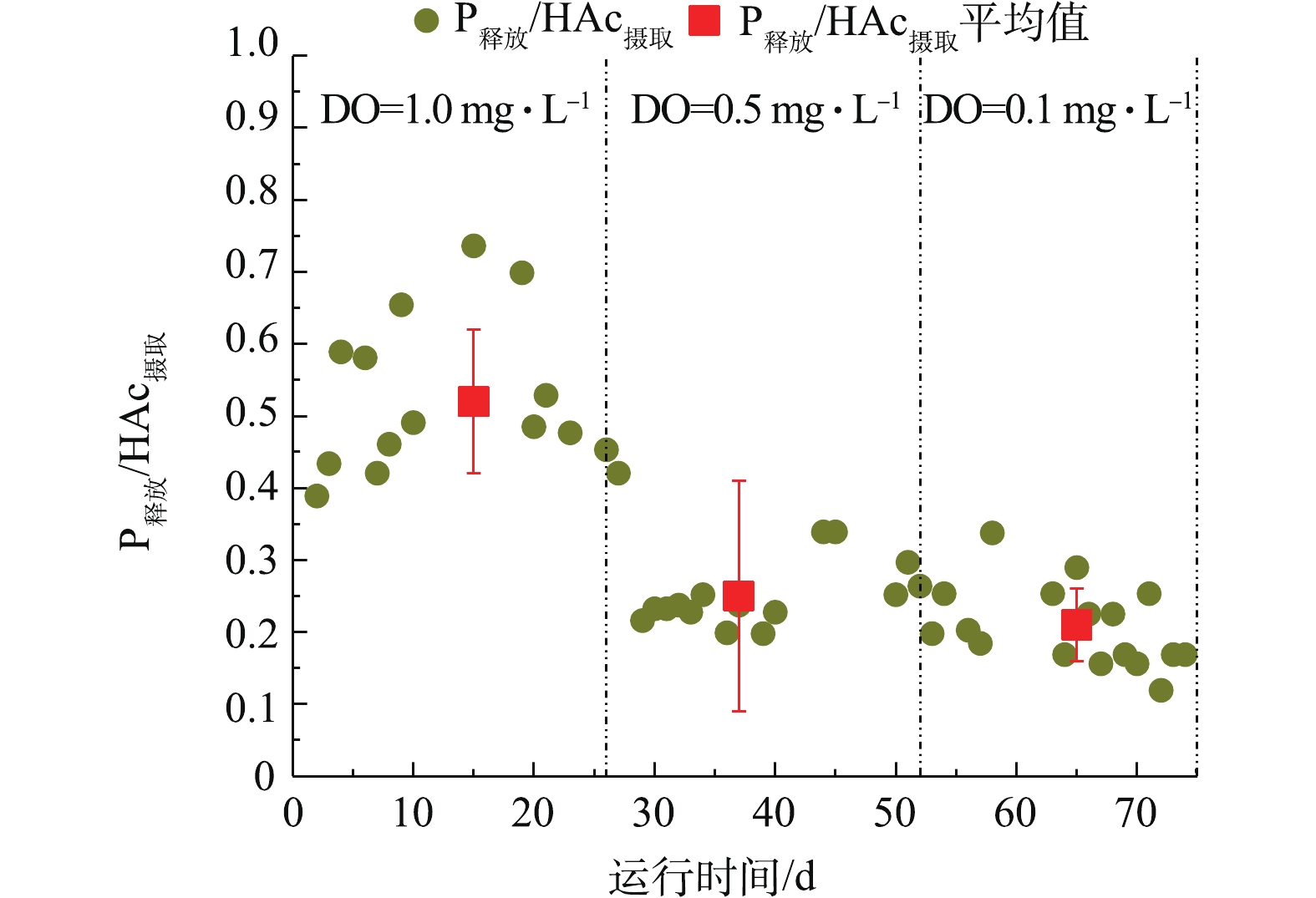-
磷作为能引起水体富营养化的主要元素,针对其高效去除的研究受到各国学者的关注。强化生物除磷(enhanced biological phosphorus removal,EBPR)工艺是目前污水生物除磷的主要方法之一,该工艺利用活性污泥系统中聚磷微生物(polyphosphate accumulating organisms,PAOs)在厌氧、好氧条件下的交替运行,通过排放富磷污泥,从而达到除磷的目的[1]。溶解氧(DO)浓度是影响生物除磷的一个重要因素[2],通常,曝气池中DO浓度控制在2~3 mg·L−1就可以取得良好的污染物去除效果,然而在实际运行过程中,很多工艺尤其是间歇流工艺会在好氧末期,出现溶解氧过高的现象(6~9 mg·L−1),过曝气不仅是一种能量的浪费,也会导致PAOs体内聚β羟基丁酸盐(PHB)不足而造成除磷性能恶化,而且还会对污泥絮体结构和污泥胞外聚合物产生影响[3]。王中玮等[4]研究发现,当DO浓度维持在0.5 mg·L−1时,污泥发生微膨胀,但可以实现污水节能处理,而马娟等[5]对不同溶解氧浓度下的生物除磷性能进行了研究,发现即使在超低DO条件(0.1 mg·L−1)下,EBPR系统也具有生物除磷可行性,这大大节约了污水处理成本。
另一方面,磷是人们日常生活中不可缺少的资源,但在自然界中,磷是从陆地到海洋的单向迁移。在此情况下,将磷从污水中的去除转变为回收利用显得尤为重要[6-8]。在从污水中回收磷的工艺中,发展较早的是20世纪60年代的Phostrip工艺,其实质是生物除磷与化学除磷相结合的工艺。侧流磷回收工艺的主流部分是常规的生物处理工艺(A/O、A2/O、SBR等),侧流部分是一个化学沉淀池,进行侧流回收时将厌氧富磷上清液(或部分好氧吸磷污泥再释磷)引入旁侧的化学沉降池,对其进行化学磷沉淀处理,最终得到含磷量较高的沉淀物,可用作肥料。受溶度积规则的限制,化学除磷在高浓度时效果较好,此时投加的化学药剂量较少,也可缩短沉淀时间[9]。EBPR系统厌氧末期,聚磷菌能充分释磷,磷浓度为原水的数倍,因此,在厌氧末期,提取富磷上清液并引入旁侧进行化学磷回收是一个有利的回收点[10]。将引入侧流部分用于磷回收的厌氧释磷上清液体积与进水体积的比值称为侧流比,由于侧流磷回收实则是对生物除磷系统中磷源的剥夺[11],故确定合适的侧流比对发挥化学磷回收和生物除磷的作用意义重大。郝晓地等[12]的研究报道,当侧流比为30%时,实现了磷资源回收和促进生物除磷效果的双重作用。马娟等[13]的研究也表明,提取1/3侧流比为最佳工况,可实现磷回收和高效生物除磷的有效结合。此外,基于本课题组对侧流磷回收系统长期运行的研究[14]发现,未控制溶解氧条件下,EBPR系统的除磷效率和出水达标率均不理想。因此,如能将溶解氧控制在较低水平并同时进行磷资源回收,可实现环境与经济效益并举。
本研究对EBPR系统实施溶解氧控制,在厌氧末期,提取1/3上清液施行磷回收,探讨了低DO浓度(1.0、0.5、0.1 mg·L−1)对EBPR侧流磷回收工艺主流系统的除磷性能和相应磷回收率的影响,并确定侧流磷回收的最佳DO浓度,为实际工程中低耗侧流磷回收提供参考。
全文HTML
-
实验装置如图1所示。实验所用SBR由有机玻璃制成,总有效容积为5.4 L。在反应器壁上的垂直方向设置一排间距10 cm的取样口,用于取样和排水,底部设有排泥口;以黏砂块作为微孔曝气器,采用鼓风机曝气,气量由转子流量计调节;反应器好氧段的溶解氧浓度采用带有Labview软件编程的计算机系统加以控制。
反应器每天运行3个周期,每个周期8 h,运行模式为:厌氧2 h(厌氧末期15 min静置沉淀,由此可将富磷上清液通过蠕动泵按1/3侧流比抽出),好氧5 h及沉淀、排水、闲置1 h。反应器运行参数:污泥龄(sludge retention time,SRT)为10 d,排水比1/3,温度为16 ℃左右。在厌氧末期,提取富磷上清液并引入旁侧进行化学磷回收,由于配水中的钙、镁离子浓度较高,投加1.0 mol·L−1NaOH溶液调节pH(8.5~9.5)后,沉淀反应40 min可实现磷回收。实验共进行75 d,反应器运行分3个工况,工况1运行时间为1~26 d,DO浓度为1.0 mg·L−1;工况2运行时间为27~51 d,DO浓度为0.5 mg·L−1;工况3运行时间为52~75 d,DO浓度为0.1 mg·L−1。
-
本实验用水为人工模拟废水,由碳源液、磷源液、氮源液、浓缩液及微量元素[15]液配制而成,pH平均值为6.760。用CH3COONa(COD=400 mg·L−1)配制碳源,KH2PO4(
${\rm{PO}}_4^{3 - }$ -P=8 mg·L−1)配制磷源,NH4Cl(${\rm{NH}}_4^ + $ -N=40 mg·L−1)配制氮源。浓缩液(1 L)由80 g MgCl2·6H2O、45 g MgSO4·7H2O、21 g CaCl2·2H2O、10 g酵母浸膏、61 g蛋白胨组成。为满足微生物生长需要,1 L模拟废水加入1 mL浓缩液和1 mL微量元素液。实验所用污泥接种自甘肃省兰州市七里河城市污水处理厂4号曝气池,该污水厂污泥具有一定脱氮除磷性能,污泥各项指标性能良好。
-
所有水样均采用定性滤纸过滤后测定,水质分析项目中
${\rm{PO}}_4^{3 - }$ -P采用钼锑抗分光光度法测定,COD采用COD快速测定仪测定,TN采用过硫酸钾氧化-紫外分光光度法测定,${\rm{NH}}_4^ + $ -N采用纳氏试剂分光光度法测定,${\rm{NO}}_3^ - $ -N采用麝香草酚分光光度法测定,${\rm{NO}}_2^ - $ -N用N-(1奈基)-乙二胺分光光度法测定,HAc采用气相色谱法测定。混合液悬浮固体浓度(MLSS)、混合液挥发性悬浮固体浓度(MLVSS)采用滤纸重量法测定、污泥沉降比(SV) 采用30 min沉降法测定。温度、DO、pH及ORP由德国Multi 3420在线测定仪在线监测。
1.1. 实验装置及运行
1.2. 实验用水水质及接种污泥
1.3. 分析项目及方法
-
图2为反应器运行过程中,不同DO浓度下系统对COD、
${\rm{PO}}_4^{3 - }$ -P的去除性能。从图2(a)可看出,整个实验阶段,系统进水COD为400 mg·L−1,出水COD均低于50 mg·L−1,EBPR主流系统对COD的去除稳定达到《城镇污水处理厂污染物综合排放标准》一级A标准。早有研究[16]表明,EBPR系统COD的去除主要发生在厌氧段,进水挥发性脂肪酸(VFAs)被PAOs吸收并在体内合成聚β羟基烷脂酸(PHAs),侧流磷回收操作是在厌氧末期进行的,该工艺的加入并不会影响EBPR主流系统厌氧段微生物对有机物的利用。所以本研究中,即使DO浓度较低,主流系统对COD的去除仍保持较高的水平。图2(b)为系统对磷的去除情况。可以看出,在工况1阶段,DO浓度为1.0 mg·L−1,进水磷浓度为8 mg·L−1,厌氧末期磷浓度均值为28.37 mg·L−1,系统对磷的去除较好,出水磷均值接近于0,去除率维持在99.0%左右。降低DO浓度为0.5 mg·L−1(工况2),系统厌氧末期释磷量下降,出水磷浓度较上一阶段升高,均值为0.37 mg·L−1,去除率均值为95.4%。在前2个阶段,主流系统出水磷达标率(出水小于0.5 mg·L−1)分别为96.0%和84.0%。在DO浓度过低(0.1 mg·L−1)的工况3阶段,系统厌氧末期磷浓度降低,均值为12.19 mg·L−1。由于此阶段硝化与吸磷对有限电子受体的竞争及吸磷时间不足,导致反应结束时系统内磷平均残留量达1.02 mg·L−1,除磷率降至87.2%。这与本课题组之前的研究结果[5]有所不同,原因是之前的实验用水中仅有少量氨氮且投加了硝化抑制剂,不存在硝化和好氧吸磷竞争溶解氧,因此,即使在很低的DO浓度下仍能完成吸磷。在工况1~工况3阶段,随DO浓度的降低,系统厌氧末期释磷量相应降低,当DO浓度过低时,系统对磷有一定的去除,但此阶段除磷达标率只有29.0%,说明超低DO条件对进行侧流磷回收的EBPR系统有一定的影响。
图3为不同DO条件下系统对各形态氮的去除性能。由图3可知,在反应器运行的75 d中,系统出水
${\rm{NH}}_4^ + $ -N均接近于0,去除率达97.5%。实验结果表明,保持1/3侧流比条件下的低耗EBPR系统对${\rm{NH}}_4^ + $ -N的去除基本没有影响[17]。工况1~工况3各阶段出水TN平均值为11.87、10.27、8.06 mg·L−1,均稳定达到《城镇污水处理厂污染物综合排放标准》一级A标准,各阶段TN去除率因出水${\rm{NO}}_3^ - $ 浓度的降低而升高。分析认为:当DO浓度降低时,利于系统内发生同步硝化反硝化,因此,出水${\rm{NO}}_3^ - $ -N降低[18]。出水${\rm{NO}}_3^ - $ -N浓度在长期侧流磷回收反应中随DO浓度降低而下降,还可能是因为有部分${\rm{NH}}_4^ + $ -N从主流反应中提取出来参与磷沉淀物的形成,从而使参与后续好氧硝化反应的${\rm{NH}}_4^ + $ -N量相应减少,故而出水${\rm{NO}}_3^ - $ -N降低。 -
图4为不同DO 条件下典型周期内
${\rm{PO}}_4^{3 - }$ -P、ORP、DO的变化规律。从图4(a)可知,工况1在厌氧阶段完成磷的释放,在后续的好氧阶段进行吸磷过程,于150 min完成吸磷。图4(b)和图4(c)为工况2及工况3典型周期内${\rm{PO}}_4^{3 - }$ -P、ORP、DO的变化规律,由此可知,至好氧反应结束时,系统中还残留0.36 mg·L−1、1.01 mg·L−1${\rm{PO}}_4^{3 - }$ -P,除磷率较低。有研究[19]表明,当好氧段DO浓度处于较低(小于0.6 mg·L−1)水平时,受传质阻力的影响,氧在活性污泥内部扩散时会受到强烈抑制,从而在絮体内部形成厌氧微环境。因此,在工况3阶段,由于好氧时段的DO浓度超低(DO≤0.1 mg·L−1),导致好氧期间PAOs吸磷速率相对更高,DO浓度水平下缓慢,后续吸磷时间不足,导致反应结束系统磷残留量较多。氧化还原电位(ORP)能够反映混合液的氧化还原状态,在生物除磷系统中,还与除磷进程关系密切。有研究[19-20]表明,ORP值和磷含量之间呈良好的相关关系,能直接反映
${\rm{PO}}_4^{3 - }$ -P浓度的变化,从而能定量反映聚磷菌的性能特征。一般而言,释磷过程伴随着ORP下降,当ORP值为负值时,绝对值越高,则其释磷能力就越强;吸磷过程则伴随着ORP的上升,当ORP为正值时,聚磷菌不释磷。因此,通常EBPR应将ORP值控制在200~−300 mV。从图4可看出,当反应进行至130 min左右时,3个工况典型周期中ORP值分别为−246.9、−232.3、−227.4 mV,达到负的最低点,这表明此时PAOs释磷能力最强,而后ORP值开始升高,PAOs吸磷过程开始。前2个工况好氧反应前期,ORP值开始转变为正值,但工况3直到好氧反应结束,ORP值仍是负值。分析原因,在DO浓度较高的情况下,系统的ORP取决于DO的浓度,而随着DO浓度的降低,ORP值迅速降低。当DO消耗完毕或接近完毕时,控制系统ORP的因素较为复杂,有机物浓度或微生物的代谢和活性也是其中的影响因素[20],所以当DO浓度极低时,影响ORP的原因还需进一步研究。 -
图5为不同DO条件下EBPR系统的比释磷、吸磷速率。由图5可知,系统比厌氧释磷速率和比好氧吸磷速率随DO浓度的降低均下降,3个运行阶段的比释磷速率分别为6.47、5.26、4.01 mg·(g·h)−1(以VSS计),比吸磷速率分别为2.54、1.97、1.55 mg·(g·h)−1。分析原因,DO浓度长期处于超低状态,微生物代谢处于相对缓慢的状态,除磷系统厌氧释磷量极低[5],进而导致系统比释磷速率降低。再者,相对于生物处理系统而言,侧流部分的磷回收对整个系统是一种磷剥夺,若活性污泥系统中的磷被分离到侧流部分进行化学磷沉淀,这会导致生物除磷系统无磷可利用,从而影响好氧阶段污泥对磷的吸收,导致系统比吸磷速率降低,系统长期运行的生物除磷功能受到一定的影响[10]。
图6给出了不同DO条件下系统厌氧段P释放与HAc摄取之比。由图6可知,系统厌氧段P释放/HAc摄取呈下降趋势,3个阶段P释放/HAc摄取平均值分别为0.52、0.25、0.21。结合图2可知,系统厌氧段释磷量随DO浓度的下降而减少,而3个反应阶段系统厌氧段摄取HAc的量变化不大,故厌氧段P释放/HAc摄取降低。分析原因,由于该EBPR系统中同样存在GAOs(非poly-P细菌),它将与PAOs(poly-P细菌)争夺有机碳源,所以系统厌氧末期释磷量降低,因此,P释放/HAc摄取比值下降。WELLES等[21-22]研究了纯培养条件下PAOs优势菌属Accumulibacter的2种类型(I型和II型),发现厌氧段P释放/HAc摄取比值变化是PAOs代谢方式的转变造成的,当PAOs体内poly-P含量较低时,PAOⅠ进行典型的聚磷代谢(PAM),而PAOⅡ则进行混合代谢(PAM-GAM),本实验中不同DO条件下P释放/HAc摄取值持续降低,可能是因为当溶解氧浓度长期处于较低状态时,PAOs体内poly-P含量也随之降低,而poly-P含量是影响EBPR系统中不同类型PAOs竞争的重要因素[23-24],长期poly-P含量较低造成PAOs代谢模式发生了转变,因此,厌氧段释磷量降低。当PAOs厌氧末期释磷性能逐渐下降时,系统会逐渐失去利用富磷上清液进行化学磷回收的优势。
-
图7为不同DO条件下磷回收与生物除磷性能。由图7(a)可知,随着DO浓度的降低,主流系统PAOs总释磷量呈下降趋势,从工况1时的25.70 mg·L−1下降至工况2的10.36 mg·L−1,在DO浓度为0.1 mg·L−1下降幅度较小;系统中生物除磷量与总释磷量趋势几乎吻合,侧流磷回收量随DO浓度的降低而减少。由图7(b)可知,EBPR系统主流工艺生物除磷率随DO浓度的降低一直下降,分别为99.0%、95.4%、87.2%,其对应侧流磷回收率也呈下降趋势。实验提取1/3侧流比进行侧流磷回收,在DO为1.0 mg·L−1时,侧流磷回收率(侧流反应化学磷回收率)较其余2个条件下较高,且此阶段下厌氧段释磷量最大,生物除磷率也达到最高(99.0%)。考虑到主流工艺的可靠运行及出水稳定性,DO浓度为1.0 mg·L−1为最佳工况。此时厌氧释磷上清液侧流磷回收工艺并未阻碍生物除磷系统正常功能的发挥,生物除磷为化学磷回收提供磷源,化学磷回收辅助生物除磷使出水磷达标排放,实现了两者共同作用[25]。
2.1. 不同DO条件下EBPR系统的污染物去除性能
2.2.
不同DO条件下典型周期内${\bf{PO}}_4^{3 - } $![]()
![]()
-P,ORP,DO的变化规律
2.3. 不同DO条件下EBPR主流系统的释、吸磷性能
2.4. 不同DO条件下磷回收、生物除磷性能
-
1)提取1/3侧流比进行低溶解氧条件下的侧流磷回收,不同溶解氧条件对主流系统的COD和
${\rm{NH}}_4^ + $ -N去除影响较小,TN去除率随溶解氧浓度的降低呈现升高的趋势。2)随着DO浓度的降低,PAOs生长相对缓慢,系统厌氧末期释磷量逐渐减少,好氧吸磷速率变缓,系统除磷性能变差。
3)尽管微好氧(DO=0.5 mg·L−1)和超低溶解氧(DO =0.1 mg·L−1)条件下也可进行磷回收,但主流工艺的出水水质和磷回收效率较差。DO=1.0 mg·L−1时,低好氧EBPR系统与侧流磷回收工艺的结合才可实现磷的高效去除与资源的同步回收。








 下载:
下载:







